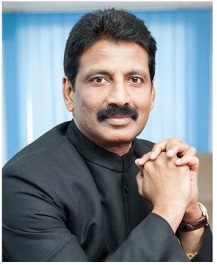CAN TECHNOLOGY SOLVE THE LYNCHING PROBLEM ?

People do not understand the complexities and constraints under which the Indian Police discharge their duties. A deliberate attempt is being made to muddy the waters and shift the blame for lynchings on to the police by alleging that the police at the behest of their political masters are shirking their responsibilities. This is not fully true. The reality is that police in India function under pathetic conditions. Our country has one of the lowest police population ratios in the world. According to the Ministry of Home Affairs, there are 17.2 million police personnel across 36 states and union territories when they should have been 22.6 million police personnel. There should be a police personnel for every 547 Indians as per the sanctioned strength but the available strength is only one for every 720. The strength of police personnel per unit area in the country i.e., per 100 sq km was 54.7 in 2013. The average strength in the police stations is extremely meagre too, 19.7% (2,837 out of total 14,394) police stations had strength of 11 – 20 personnel, 16.9% police stations had strength of 21 – 30 personnel and 6.1% police stations had strength of police personnel less than 10.Nearly 90% of police station staff, across the states and across various police station types, presently work for more than 8 hours a day. Further, more than 68% of Station House Officers (SHOs) and over 76% of the supervisory officers, staff members of their police stations have to remain on duty for 11 hours or more per day.
When it comes Lynching appears to be mostly a rural phenomenon. When I was working as a Superintendent of Police in districts, the average manpower sanctioned to a rural police station was no more than 20, but the list of duties to be attended to was endless. After distribution of essential duties by the SHO during the roll call, there would be none left to attend to emergent duties, in case they erupted all of a sudden. Each rural police station on an average had jurisdiction over 15 to 20 villages with innumerable hamlets, and it normally policed a population which was anything between 50000 to 100000 people. In India, to this day several rural police stations lack even a single vehicle, or a phone or a wireless set. According to Bureau of Police Research and Development, New Delhi, there are 188 Police Stations without a vehicle, 402 without telephone and 134 without wireless sets. Under the circumstances, does it appear right to blame the police in rural settings for not taking swift action in lynching cases? The urban police stations, on the other hand, have better strength, smaller jurisdictions and good infrastructure, therefore they do a good job when lynchings happen in their jurisdiction. For instance, when Maruti Suzuki’s HR Manager was lynched by the factory workers in July 2012, the police were able to swing into action in no time and arrest all the 148 workers and charge them under murder.
Improving the strength and infrastructure in the police stations cannot happen overnight. Neither can a new law magically eradicate lynching. But policing can be made more efficient and effective at a fraction of a cost by the adoption of new technologies. A police constable approximately on average costs the Government ₹2.5 lakhs a year. Added to it is a huge recurring expenditure as well. Technology, on the other hand, would require only a one-time investment and an AMC (Annual maintenance contract). Deploying technology, therefore, would greatly help in developing cost-effective solutions that will help get a firm grip on the factors responsible for lynching. This would not only enhance the efficiency of the police but also help restore the faith and confidence of the public in the police.
Possession of bovine meat was one of the factors recently responsible for the lynching of many individuals. A simple solution that could have saved people could have been the deployment of a simple DNA technology called Polymerase Chain Reaction (PCR) in Police Forensic Laboratory or the State Food Safety Laboratories. This DNA amplification and sequencing method have been applied all over the world for accurate identification of food components and precise detection of contaminants. Advances in this technique over the last decade have made it possible to identify ingredients at a molecular level from a combination of meats. This technique can easily help in establishing whether the meat or the cooked food being possessed by any suspected person contains beef or not.
Another important factor for lynching has been the inability on the part of police to reach the scene and establish the identity of the accused. UAVs (Unmanned aerial vehicles) can be powerful surveillance tools as they can reach the scene of lynching especially in rural areas with difficult terrains and inaccessible roads, swiftly by carrying camera systems as well as radio equipment and other sensors. Drones can also chase down criminals and vehicle although legal privacy concerns exist regarding the use of drones. Unmanned aerial vehicles have been used for domestic police work in Canada and the United States. Rajasthan police under the modernisation scheme have purchased 10 drones and have proposed to buy 30 more soon. Tamil Nadu police have also been deploying drones with face recognition software to maintain law and order during Thevar festival in Ramnad district and during Diwali festival season in Chennai City. Drones could immensely help the police by transmitting video graphic evidence of the accused involved in lynching directly from the scene which could eventually lead to successful prosecution.
To identify missing persons, DNA identification tests are being used all over the world for nearly 30 years. They are also being used to confirm family relationships and identify biological traces in criminal cases. In Slovenia, DNA identification tests have been used for more than two decades. DNA profiling has also been used to identify victims of mass disasters such as earthquakes, floods, fires, air crashes, train accidents, terrorist attacks et cetera. A missing persons personal items or his or her personal tissue samples collected from his or her relatives could be used for identification purposes. In this connection, in 2012 Lokniti, an NGO filed a public interest litigation in Supreme Court of India requesting the establishment of a DNA database, basing their argument that right to be identified was also a part of the right to dignity. This case is still pending in the Supreme Court. The government of Maharashtra has already proposed to carry out DNA tests on children and establish an online DNA database to reunite the children with their families. A careful and responsible use of biometric data, as well as DNA test reports, can go a long way in addressing the issue of missing and “found but untraced “children. Integration of the DNA data of the children with Aadhar card scheme is an excellent idea but DNA data is sensitive -it would have to be handled carefully and responsibly. Police in Delhi was able to identify nearly 3000 missing children within just four days of launching a new facial recognition system. The use of this facial recognition technology on around 45,000 children throughout the city, also helped establish 2930 missing children. Once the public comes to know that all hope is not lost even when their children go missing and that they can still be traced by using aforesaid technologies they would feel less helpless and not resort to mobocracy.
Crippling rumours and curbing misinformation is the next big challenge to the police when it comes to lynching. India is one of the few countries which falls prey to viral messages on social media. The recent incidents have exposed the lack of intelligence machinery in some states that caught the police napping despite the spread of rumours for hours and in some cases for days before an attack on unsuspecting victim took place. Monitoring of Facebook and Twitter has not been much of a problem but the penetration of Whatsapp has been a cause of serious concern. Whatsapp messages are encrypted and this has been posing a serious challenge to police. Fortunately, Whatsapp on its own has now decided to incorporate features in the app which supposedly could reduce the spread of rumours significantly. Police could also do their bit by creating Whatsapp helplines to bust rumours in real time. They could also gain the confidence of the public by quickly responding to rumours. This could go a long way in preventing messages from going viral. During the Jallikattu agitation in Tamilnadu, a software called “Social Media Monitoring Software “ to monitor the social media was contemplated to be developed in collaboration with the IIT, Madras. Expeditious implementation of this project could prove valuable in effectively dealing with rumours in future.
It’s possible that, in future, when the public come across a person carrying suspicious meat – the meat sample would be turned over to police for DNA analysis. It’s possible that when the villagers come across suspicious people in remote areas – they would get them identified by requisitioning drones with face recognition systems. It’s possible that when social media rumours happen – police would get them busted in real time by using the monitoring software, and when children go missing its possible that technology would come to their rescue in tracing them. It’s possible that by leveraging technology and good policing- police would earn enormous goodwill and confidence of the people. It’s possible that the multiplier effect of technology will tremendously enhance the effectiveness of the police – and lynching would soon become a thing of the past.
A Virginia planter, and American Revolutionary named Charles Lynch (1736-1796) who headed an irregular court in Virginia, USA to punish loyalist supporters of British during the American Revolutionary War would never have dreamt even in his wildest dreams that the term lynching, which is derived from his name would get so eternalised and become the new normal in our country. Lynching or mobocracy has become so common and widespread that it’s not uncommon to see people, getting lynched for eating beef, for Facebook posts, for suspected child trafficking, for falling in love with people belonging to other communities, and for speaking against religious fundamentalism. Our country, between 2010 and 2017 witnessed 63 incidents of bovine-related lynchings in which 28 people were killed out of which 24 belonged to the Muslim community. Quite shockingly, a sharp spike of lynchings was noticed during the last three years, with 97 per cent of incidents being recorded during this period.
Under normal circumstances, it is extremely difficult for a human being to bring himself to kill another fellow human being unless he happens to be a sociopath or a mentally deranged person. A normal person has inbuilt inhibition which prevents him from taking the life of others, unless and until there is a special environment or a situation which transmogrifies the mind of the perpetrator to dehumanise the victim and think of him as less than human. The attackers in most lynching cases think of themselves as higher beings and the victims outside their group as lower beings who deserve to be abused and killed. The combination of a dehumanised mind and a heart full of pent-up fury can be devastating. Modern day living has generated a lot of pent-up fury amongst Indians due to acute joblessness, poverty, envy, sexual frustration, extraordinary external stimuli, social media, unhappy jobs, inferiority complex et cetera. So much so, that even a small spark when tagged on to that special environment, is more than sufficient to ignite and unleash all that pent-up fury bottled inside them- And in a flash, herd mentality sets in, common sense is forsaken and perpetrators go berserk beating up victims, pelting stones, ransacking shops, burning buses and destroying everything that comes their way. Long before even an iota of sanity has sunk in, a lynching has occurred.
Do we need a new law on lynching? Supreme Court recently proposed that a new enactment was necessary against lynching. To every major societal problem, people think, a new law, is a right answer to a problem. Governments gladly grab the opportunity to wriggle out of an insurmountable problem by enacting a legislation which temporarily helps them gain the confidence of the people. In 2012 the brutal gang rape of a 23-year-old medical student, which came to be known as Nirbhaya, triggered public outrage across the country similar to the lynchings of today. The government came under intense pressure and three months laterpassed “The Criminal Law (Amendment) Act 2013 “based on the recommendation of a Judicial Committee. Consequently, the definition of rape was changed and amendments were executed in the Indian Penal Code, Indian Evidence Act, Code of Criminal Procedure, and laws related to sexual offences. The Juvenile Law was also amended to treat rapists between 16 and 18 as adults. Despite launching fast-track courts and a rape law that included the death penalty, the crime statistics today indicate, that the situation has gotten worse, not better, since then. Statistics reveal that since 2012, rape cases climbed 60 per cent from 24,293 cases to around 40,000 cases in 2016, with child rape accounting for about 40 per cent of cases. The conviction rate of people arrested for rape remained stuck around 25 per cent and the fast track courts of Delhi had a backlog of 3487 cases this year. Recently in Chennai, the provisions of the newly enacted rape law miserably failed to prevent an 11-year-old girl with a hearing disorder, from being allegedly gang-raped by at least 22 men for over 7 months.
The problem with our country ostensibly is that we have a plethora of laws. We get this compounded further by getting new laws enacted at the drop of a hat. Most of the laws enacted in the past have become obsolete today. Knowing this fully well, our Prime Minister as a part of the campaign on “Minimum Government Maximum Governance “ took upon himself the task of initiating a slew of measures to repeal obsolete laws. As a result of which 1200 laws have been repealed and 1824 laws are waiting to be axed. This being the case enactment of a new anti-lynch law makes no sense at all.
Adequate provisions already exist in IPC to deal with lynching, even if there is no mention of the word lynching. Lynching is basically murder. The punishment for murder is life imprisonment. There can’t be any punishment more than that. In the IPC, lynching can be dealt with under section 302 (murder), section 307 (attempt to murder), section 323 (causing voluntary hurt), section 153 A (promoting disharmony), section 147 (rioting) section 148 (rioting armed with deadly weapons), 149 (unlawful assembly). IPC also has comprehensive provisions not only on hate speech but also on hate action. The Law Commission recently suggested incorporation of new provisions in IPC to curb hate speech. A draft amendment bill namely the Criminal Law Amendment Bill suggests insertion of a new section 153 C (prohibiting incitement to hatred) and section 505 A (causing fear, alarm or provocation). This only gives credence to my belief, that not getting to the root of the problem and symptomatically treating the malaise of mob-violence by enacting new laws, would in no way prevent or eradicate the problem.
Instead, the Supreme Court would have done well, had it directed the states to rely on technology to get a firm hold on the lynching issue as a short-term strategy. For the long-term, it could have requested the Government to introduce measures to improve employment and education. I strongly believe that a technology-driven, more intelligent enforcement mechanism working within the existing legislative and judicial system would be far more effective in addressing the concerns of lynching. I do not know, how a policing system which is already overburdened and reeling under financial constraints be helped by a new law.
Source from: epaper/deccanchronicle/chennai/dt:30.07.2018 & 31.07.2018
 Dr.K. Jayanth Murali is an IPS Officer belonging to 1991 batch. He is borne on Tamil Nadu cadre. He lives with his family in Chennai, India. He is currently serving the Government of Tamil Nadu as Additional Director General of Police, DVAC.
Dr.K. Jayanth Murali is an IPS Officer belonging to 1991 batch. He is borne on Tamil Nadu cadre. He lives with his family in Chennai, India. He is currently serving the Government of Tamil Nadu as Additional Director General of Police, DVAC.


